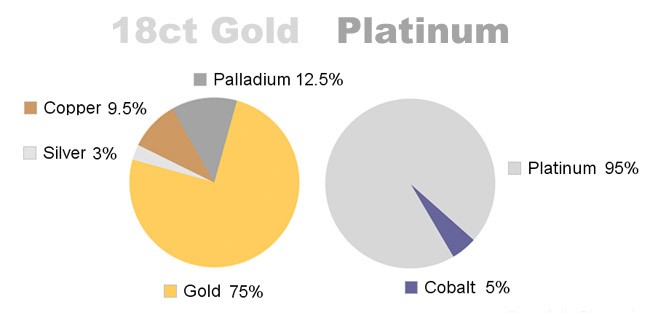Platinum and white gold are both popular choices for jewelry, especially engagement rings. But which metal is harder and more durable? This article explores the hardness and durability of platinum versus gold, examining their composition, properties, and suitability for different jewelry styles.
Understanding Platinum and White Gold
Platinum and white gold differ significantly in their composition. While both are often alloyed with other metals for jewelry applications, platinum boasts a much higher purity.
950 platinum, commonly used in jewelry, is 95% pure platinum. In contrast, 18ct white gold (stamped 750) contains only 75% gold. The remaining 25% consists of alloys like silver, palladium, and nickel, added to enhance its hardness and color. White gold’s white hue comes from rhodium plating, applied after polishing to give it a bright, reflective finish. Without plating, white gold has a slightly yellowish tint.
Platinum’s Hardness vs. White Gold’s Hardness
While 18ct white gold is technically harder than platinum on the Mohs scale, measuring resistance to scratching, this doesn’t tell the whole story. Platinum is denser and more durable than white gold.
Although platinum scratches more easily due to its lower hardness, these scratches are merely surface displacements. The metal is not lost, but rather moved aside. This means platinum develops a patina over time, a soft, satin-like finish some find appealing. It can also be easily polished back to its original shine.
Conversely, when 18ct white gold scratches, it loses some of its metal. Over time, this can lead to thinning and weakening of the piece.
Malleability and Durability: Platinum vs. Gold
Platinum’s superior density and malleability make it exceptionally durable. While less hard than white gold, it’s less likely to bend or deform under pressure. This makes it ideal for securing gemstones, particularly diamonds, as the prongs will hold their shape and grip better over time.
Platinum’s durability makes it a great choice for intricate settings and delicate designs.
18ct white gold, being harder, is more brittle than platinum. It’s more resistant to surface scratches but more susceptible to breaking under stress.
Long-Term Wear and Maintenance
Platinum’s natural white color never fades, requiring no re-plating. White gold, however, needs periodic rhodium re-plating to maintain its bright white finish.
While 18k white gold initially appears bright white, it can develop a yellowish tinge over time as the rhodium plating wears off. This requires re-plating every few years, depending on wear.
Choosing Between Platinum and Gold
Platinum’s durability, natural white luster, and hypoallergenic properties make it a premium choice for fine jewelry. However, it is typically more expensive than gold. White gold offers a more affordable option, but requires more maintenance to maintain its appearance.
Platinum’s timeless elegance makes it a popular choice for vintage-inspired designs.
Ultimately, the best choice depends on individual preferences, budget, and lifestyle. Consider factors like durability, maintenance, and desired aesthetic when making your decision. If you prioritize long-lasting brilliance and minimal upkeep, platinum is an excellent investment. If budget is a primary concern and you don’t mind occasional re-plating, white gold is a beautiful and viable alternative.
